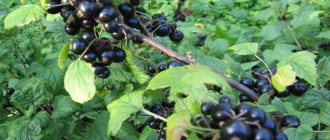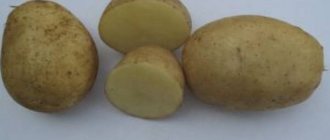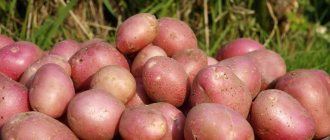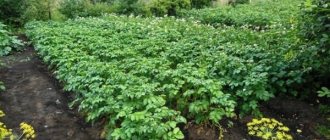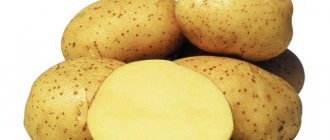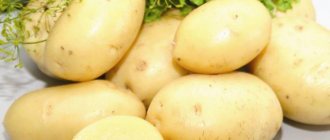Origin story
The Giant variety was obtained by domestic breeders. It has been in the State Register of the Russian Federation since 2013. The originator is the All-Russian Research Institute of Potato Farming named after. A. G. Lorkha, located in the Moscow region. Giant potatoes are approved for cultivation in 3 Russian regions: Central Black Earth, Central and Volga-Vyatka. It can be cultivated both in private household plots and on farmers’ plots and large industrial fields. The variety is mid-season, the tubers are for table use.
Peculiarities
This variety was obtained at the All-Russia Research Institute. Lorja. According to the recommendations of the selection group, it is intended for the center of the European part, for the Central Black Earth Region and for the Volga-Vyatka region.
The basic lines of culture during work were “946-3” and “Effect”. A description of the variety indicating its main parameters was included in the national register in 2013.
On the field, “Giant” stands out for its height. Its flowers have small or medium corollas. The foliage is large in size, it belongs to the intermediate category and is colored dark green. The tubers have a shape transitioning from oval to circle, the color is light beige, the eyes are located at a moderate depth. The weight of one tuber does not exceed 0.145 kg. When cut, the potatoes are white with a creamy tint. The maximum starch concentration is slightly less than 19%. From 1 hectare you can get up to 424 centners of crop, the preservation rate (keeping quality) is 97%.
Description and characteristics
Potato Giant forms tall, semi-erect bushes with well-developed roots. It does not have overly spreading stems and moderate foliage. The leaf is large, dark green in color, matte, with a faint wave along the edges. Potatoes bloom with small or medium-sized red-violet flowers collected in compact inflorescences. Flowering is short-lived.
Tubers of the Giant variety are oval-round, large, uniform in size, reaching a weight of 100-140 g. They have a smooth, glossy, moderately thin skin of a light beige color. There are few eyes, they are small and medium in size, reddish in color, and located shallowly. The potato flesh is creamy in color and has an excellent taste. The starch concentration in this potato is high and reaches 16-19%.
The Giant variety exhibits excellent resistance to many dangerous diseases of this crop, for example, cancer, leaf curl, common scab, wrinkled and striped mosaic, and rhizoctonia. Potato Giant is moderately resistant to late blight on leaves and tubers, but can be affected by potato nematode.
Similar varieties
The Nakra potato is less known among gardeners, but it is not inferior in characteristics to the varieties listed above. The variety is grown in the eastern regions of the country - from the Urals to the Far East. Less known in the western regions of the country.
- Among the characteristics are:
- Productivity up to 400 centners per hectare.
- High culinary qualities.
- Ripening period up to 95 days.
- Starch content 12% - 19%.
- The color of the peel is red-pink, the flesh is white with yellowish tint.
- Well kept.
- Resistant to mechanical damage.
The root crop is resistant to late blight, scab, and cancer, but infection by nematode is possible. When choosing seed material, carefully inspect the seeds for damage and disease. They are grown using standard technology, on slightly acidic soils fertilized with organic fertilizers.
Growing early table potatoes allows you to obtain a valuable food product in mid-summer. Boiled new potatoes with dill and lightly salted cucumbers will not leave anyone indifferent.
Advantages and disadvantages
Many vegetable growers are attracted to the Giant potato by its smooth, large tubers of excellent commercial quality and taste. When cleaned, they do not change color, do not darken, and after cooking they do not become overcooked, but acquire a delicate taste and aroma. You can use Giant potatoes to prepare all sorts of dishes that include potatoes: they look great in any of them, decorate them and make the taste more harmonious. Due to the high concentration of starch, these potatoes are used to make starch and to make dry mashed potatoes.
In addition to this undoubted advantage, the Giant variety of potatoes demonstrates:
- resistance of seed tubers to degeneration;
- good tolerance to drought and high temperatures;
- marketability of harvested tubers is 87-98%;
- high yield (from 1 sq. m of beds allocated for this potato, you can collect 2.9-4.2 kg of tubers, which is 0.6-1 kg higher than the yield of varieties such as Petersburg and Chaika, recognized as the standard).
- excellent keeping quality of the crop (97% of tubers can last until the end of storage).
No significant deficiencies were identified in potatoes of this domestic variety. Its features include intolerance to stagnation of moisture in the ground and some demands on the type of soil: it grows poorly on heavy loams.
Early pink
Potatoes "Lyubava" differ from imported potato varieties with an average potato content and excellent taste. Among the disadvantages is vulnerability to the Colorado potato beetle, but they can be completely destroyed with chemicals.
Characteristics of the potato variety “Lyubava”:
- Low bushes.
- The flowers are red-violet.
- A very early variety. (The first tubers can be obtained in mid-July)
- High yield. (Average tuber weight 120-150 g.)
- The color of the tubers is pink, the flesh is white.
- Drought resistant, responsive to watering.
- Resistant to nematodes and potato cancer.
Seed potatoes are carefully selected to avoid infection with scab disease. It is demanding on the quality of the soil and the content of nutrients in it. An ideal option for table early potatoes.
Landing
In order to harvest a good harvest of Giant potatoes, the soil must be prepared in advance: dug up and fertilized in the fall or spring. During autumn preparation, the site is dug up deeply and applied to each square meter. m, 1-1.5 buckets of humus and 0.5 kg of ash and leave the soil in the layers until spring, and level them in the spring. Acidic soil is limed to achieve a neutral reaction. If soil preparation for Giant potatoes occurs in the spring, then it is dug up and fertilized at least 2 weeks before planting the tubers. Mixtures of mineral origin are used as fertilizers.
This variety of potatoes can be planted in 3 different ways: under a shovel, in ridges or trenches. Which one is best suited in each specific case depends on the type of soil on the site. On light sands and sandy loams it is preferable to plant in trenches, on loams - in ridges. But no matter what method is chosen, it is better to use the Velikan variety treated with fungicides, growth stimulants and germinated tubers: this way the potatoes will sprout faster and the harvest can be obtained earlier. Cutting potatoes into pieces is not recommended.
Planting under a shovel is a traditional method that is suitable for cultivated areas with fertile soil, where vegetables have been grown for many years. The place for potatoes should be level, without stagnant water, well lit and warmed by the sun. Planting Giant potatoes in this way is simple: just dig a hole with a shovel, throw fertilizer and a tuber into it and cover it with soil.
If the soil on the site is loose, does not retain moisture well, or the climate of the area is hot and dry, then the best planting method is planting in trenches. Burying into the ground will save the tubers from overheating and drying out. This planting method is not suitable for dense and moist soils that do not have good air exchange and where moisture stagnates.
For such soils, planting in ridges is suitable. Its peculiarity is the preliminary cutting of ridges approximately 20 cm high. Tubers of the Velikan variety are placed in them, and then covered with soil.
Important! Raised beds reliably protect potatoes from getting wet and prevent the development of fungal diseases.
It must be said that this method is often chosen by those gardeners who have a walk-behind tractor or a walk-behind cultivator on their farm. With their help, you can complete all work quickly and efficiently, with a minimum of physical effort.
How to plant Giant potatoes correctly
Before planting Giant potatoes, you must prepare the soil. It is necessary to dig up and add fertilizer in the autumn or spring. During autumn preparation, the dacha plot needs to be dug up well, humus (at the rate of 1-1.5 buckets per 1 sq.m.) and ash (0.5 kg) must be added and the soil should be left in layers until spring, and leveled in the spring. layers. If you prepare the soil in the spring, then you need to dig it up and add fertilizer about 2 weeks before you start planting the tubers. Use mineral fertilizers.
Seed potatoes Giant: photo of the variety
Care
Potato Giant does not require special care. All it needs is rare but abundant watering, loosening, hilling and fertilizing. Water potatoes of this variety 3 times per season:
- before the first hilling;
- before flowering;
- after him.
So much water is poured under each Giant potato bush so that the soil is wet to the depth at which the entire root system is located. After it dries a little, it is carefully loosened, trying not to touch the roots, stems and developing tubers. If the weather is hot during the period of increased tuber growth, then the potatoes will have to be watered more often, but if it rains at the time of planned watering, then there is no need to water.
Hilling and feeding
The first hilling of the Giant potatoes is carried out when the height of the tops of young bushes reaches a height of 20 cm. The soil is raked on them manually using a hoe or a walk-behind tractor with a simple or disk hiller is passed along the rows. The ridges are trimmed several times during the growing season of the plants, raising and expanding them as the bushes grow. It is especially important to hill up potatoes of this variety after the tubers have begun to lay.
Giant potatoes are fed with both organic matter and mineral fertilizers. They are applied in the form of root and foliar fertilizers. The first fertilizing is done after the shoots appear. At this time, potatoes need nitrogen, so they are watered with slurry (1 to 10), herbal infusion or saltpeter. In the second feeding of the Giant potato (before flowering), nitrogen is excluded, but phosphorus is used as part of superphosphate; in the third (after flowering), potassium is used in any potassium-containing mixtures, except those that contain chlorine. All mineral fertilizers are dosed according to their instructions. You can replace phosphorus-potassium fertilizers with a solution of ash, which contains all the basic nutrients + microelements.
Peculiarities
This variety was obtained at the All-Russia Research Institute. Lorja. According to the recommendations of the selection group, it is intended for the center of the European part, for the Central Black Earth Region and for the Volga-Vyatka region.
Potatoes belong to the mid-season category and can be used not only for culinary purposes, but also as a raw material for the production of starch.
The basic lines of culture during work were “946-3” and “Effect”. A description of the variety indicating its main parameters was included in the national register in 2013.
On the field, “Giant” stands out for its height. Its flowers have small or medium corollas. The foliage is large in size, it belongs to the intermediate category and is colored dark green. The tubers have a shape transitioning from oval to circle, the color is light beige, the eyes are located at a moderate depth. The weight of one tuber does not exceed 0.145 kg. When cut, the potatoes are white with a creamy tint. The maximum starch concentration is slightly less than 19%. From 1 hectare you can get up to 424 centners of crop, the preservation rate (keeping quality) is 97%.
Diseases and pests
The main problem of the Giant variety is that it can be affected by nematodes. If this happens, there will be no harvest. There are no drugs that would destroy the pest if it has already infected the potatoes, so only preventive measures remain: nematicides are applied to the soil of the potato plot at least a month before planting. This period is necessary, since the preparations have a phytosuppressive effect, so they cannot be used on growing potatoes.
Advice! In cool and humid summers or in the second half, when it may already be cold and damp at night, Giant potatoes are sprayed with fungicides against late blight.
Plantings are also treated against beetles, mole crickets, potato moths and wireworms. Use fungicides or products made according to folk recipes.
Record potato size
The title “The largest potato in the world” has belonged to a vegetable weighing 11 kg 200 g since 2008.
The Farmer Who Raised a Giant
Farmer Khalil Semhat from Saudi Arabia grew the record holder, surpassing European and American vegetable growers. Khalil and his huge potato are listed in the Guinness Book of Records. The size of the vegetable is equal to the girth of three human heads. Variety – yam (sweet potato).
The Arabian surpassed the previous achievement of the Englishman in 1975, growing a vegetable three kilograms heavier. Khalil himself admits that he did not expect to unearth such a huge tuber on his site and was quite surprised when he weighed this “monster.”
The most popular question that the record holder now hears is how he managed to grow such potatoes and what he fertilized them with. However, professionals will be disappointed: Semhat did not use “secret technologies.” Moreover, the farmer admitted that he did not fertilize the vegetable and did not even take special care of it. The potatoes grew on their own, and this is what came out of it. Such huge potatoes can feed an entire village! The size of the harvest is amazing even in the photo.
After becoming a celebrity, Khalil Semhat became even more interested in vegetable growing. Now his harvest is particularly popular with buyers, and the farmer himself continues to actively grow a variety of fruits and vegetables. Perhaps the Arabian hopes to find another record holder in his garden.
Harvesting
Giant potatoes are harvested approximately 3 months after planting in the beds. At this time, its tops should turn yellow and begin to dry: this indicates that its growing season and the process of tuber formation are completed. To speed up this process, 1-2 weeks before the expected harvest date, the tops of the bushes are broken or cut off.
They dig up tubers of the Giant variety with a shovel, or in wet weather with a pitchfork. Then they are laid out to dry directly on the beds (in good weather) or transferred to a dry room. After drying, which takes several days, the potatoes are sorted, cut ones, damaged ones, and small ones are selected and stored separately. The rest is poured into boxes, bags or small plastic nets intended for storing vegetables. The harvest is placed in the cellar for storage.
Features of cultivation
For planting, smooth, medium-sized tubers that are not damaged by pests are selected. The seed material is treated and treated with growth stimulants. 4 weeks before planting, the tubers are laid out in the light for germination.
Important: Cutting root vegetables before planting is not recommended. Root crops with strong and fairly long sprouts are selected for planting. Potatoes prefer light sandy soils, as well as chernozem with a neutral or slightly alkaline reaction.
Excessively acidic soil can be treated with lime or gypsum, 20 kg will be needed for each hundred square meters. Yields are reduced on heavy loams
Potatoes prefer light sandy soils, as well as chernozem with a neutral or slightly alkaline reaction. Excessively acidic soil can be treated with lime or gypsum, 20 kg will be needed for each hundred square meters. On heavy loams, productivity decreases.
To increase productivity and prevent diseases, it is recommended to plant potatoes in fields that were occupied by green manure: lupine, phacelia, oilseed radish. Lands on which legumes, cabbage, and carrots grew are also suitable. To increase nutritional value, humus, peat, and wood ash are added to the soil.
Sandy soils need to be replenished with old manure, which has a great effect on yields. It is also possible to feed with mineral complexes based on phosphorus and potassium.
You should not overuse nitrogen-containing fertilizers; the tops will be very lush and the tubers will begin to shrink.
10 days before harvest, foliar feeding is possible. The bushes are generously sprayed with an aqueous solution of superphosphate. Read more about how to feed potatoes, when and how to apply fertilizers, and how to do it correctly when planting.
Potatoes can easily tolerate a slight lack of moisture, but constant drought is destructive for them. In hot summer conditions, it is necessary to organize drip irrigation or sprinkling. In extreme cases, plantings are watered manually, soaking the soil to a depth of 50 cm.
During the season, the bushes need to be hilled at least 2 times, forming high ridges and removing weeds. Mulching the soil with mown grass or straw has a good effect; it protects the plantings from pests and maintains a normal level of moisture in the soil. Mulching is especially recommended on sandy soils and in regions with hot climates.
Harvesting is carried out at the end of the growing season, 3 months after planting. A week before digging, you need to cut off the tops from the bushes so as not to interfere with the tubers accumulating nutrients and gaining weight. The collected potatoes are laid out for drying on the boundary; in rainy weather, the crop can be stored under a canopy. Seed potatoes are sorted and stored separately.
Useful tips for gardeners
To get an excellent harvest, it is necessary to assess the condition of the soil and plants during the growth process and take timely measures to correct problems. Therefore, experienced farmers have developed a number of recommendations that help prevent disease incidence or reduce the consequences for the marketability and volume of the crop.
Basic tips for growing potatoes:
- It is possible and necessary to influence the quality of the soil. Do this with fertilizers and fungicides. They inhibit pathogenic flora and promote the development of colonies of beneficial bacteria.
- Inorganic fertilizers are well absorbed by plants, but have no effect on the soil, so combine organic and inorganic to improve the condition of the soil. This increases yield and minimizes diseases.
- When choosing a planting method, take into account the density and composition of the soil, as well as the humidity characteristics of the site.
- Plant seed and remember to renew it every 3-4 years.
- Sprout potatoes before planting.
- Be sure to hill up potatoes to increase the yield of bushes.
The Giant variety has excellent characteristics. It is suitable for cultivation both in private farms and for use on an industrial scale. Ease of cultivation is an additional advantage. And if you are choosing which variety to plant on your site, then pay attention to the Giant.

